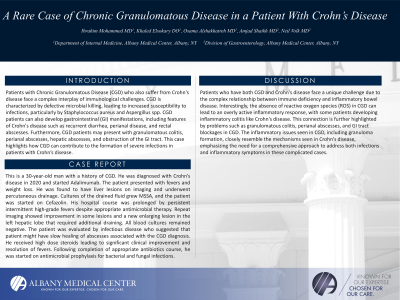Sunday Poster Session
Category: Colon
P0281 - A Rare Case of Chronic Granulomatous Disease in a Patient With Crohn’s Disease
Sunday, October 27, 2024
3:30 PM - 7:00 PM ET
Location: Exhibit Hall E

Has Audio
- IM
Ibrahim Mohammed, MD
Albany Medical Center
Albany, NY
Presenting Author(s)
Ibrahim Mohammed, MD, Khaled Elsokary, DO, Osama Alshakhatreh, MD, Amjad Shaikh, MD, Neil Volk, MD
Albany Medical Center, Albany, NY
Introduction: Patients with Chronic Granulomatous Disease (CGD) who also suffer from Crohn's disease face a complex interplay of immunological challenges. CGD is characterized by defective microbial killing, leading to increased susceptibility to infections, particularly by Staphylococcus aureus and Aspergillus spp. CGD patients can also develop gastrointestinal (GI) manifestations, including features of Crohn's disease such as recurrent diarrhea, perianal disease, and rectal abscesses. Furthermore, CGD patients may present with granulomatous colitis, perianal abscesses, hepatic abscesses, and obstruction of the GI tract. This case highlights how CGD can contribute to the formation of severe infections in patients with Crohn’s disease.
Case Description/Methods: This is a 30-year-old man with a history of CGD. He was diagnosed with Crohn’s disease in 2020 and started Adalimumab. The patient presented with fevers and weight loss. He was found to have liver lesions on imaging and underwent percutaneous drainage. Cultures of the drained fluid grew MSSA, and the patient was started on Cefazolin. His hospital course was prolonged by persistent intermittent high-grade fevers despite appropriate antimicrobial therapy. Repeat imaging showed improvement in some lesions and a new enlarging lesion in the left hepatic lobe that required additional draining. All blood cultures remained negative. The patient was evaluated by infectious disease who suggested that patient might have slow healing of abscesses associated with the CGD diagnosis. He received high dose steroids leading to significant clinical improvement and resolution of fevers. Following completion of appropriate antibiotics course, he was started on antimicrobial prophylaxis for bacterial and fungal infections.
Discussion: Patients who have both CGD and Crohn's disease face a unique challenge due to the complex relationship between immune deficiency and inflammatory bowel disease. Interestingly, the absence of reactive oxygen species (ROS) in CGD can lead to an overly active inflammatory response, with some patients developing inflammatory colitis like Crohn's disease. This connection is further highlighted by problems such as granulomatous colitis, perianal abscesses, and GI tract blockages in CGD. The inflammatory issues seen in CGD, including granuloma formation, closely resemble the mechanisms seen in Crohn's disease, emphasizing the need for a comprehensive approach to address both infections and inflammatory symptoms in these complicated cases.
Disclosures:
Ibrahim Mohammed, MD, Khaled Elsokary, DO, Osama Alshakhatreh, MD, Amjad Shaikh, MD, Neil Volk, MD. P0281 - A Rare Case of Chronic Granulomatous Disease in a Patient With Crohn’s Disease, ACG 2024 Annual Scientific Meeting Abstracts. Philadelphia, PA: American College of Gastroenterology.
Albany Medical Center, Albany, NY
Introduction: Patients with Chronic Granulomatous Disease (CGD) who also suffer from Crohn's disease face a complex interplay of immunological challenges. CGD is characterized by defective microbial killing, leading to increased susceptibility to infections, particularly by Staphylococcus aureus and Aspergillus spp. CGD patients can also develop gastrointestinal (GI) manifestations, including features of Crohn's disease such as recurrent diarrhea, perianal disease, and rectal abscesses. Furthermore, CGD patients may present with granulomatous colitis, perianal abscesses, hepatic abscesses, and obstruction of the GI tract. This case highlights how CGD can contribute to the formation of severe infections in patients with Crohn’s disease.
Case Description/Methods: This is a 30-year-old man with a history of CGD. He was diagnosed with Crohn’s disease in 2020 and started Adalimumab. The patient presented with fevers and weight loss. He was found to have liver lesions on imaging and underwent percutaneous drainage. Cultures of the drained fluid grew MSSA, and the patient was started on Cefazolin. His hospital course was prolonged by persistent intermittent high-grade fevers despite appropriate antimicrobial therapy. Repeat imaging showed improvement in some lesions and a new enlarging lesion in the left hepatic lobe that required additional draining. All blood cultures remained negative. The patient was evaluated by infectious disease who suggested that patient might have slow healing of abscesses associated with the CGD diagnosis. He received high dose steroids leading to significant clinical improvement and resolution of fevers. Following completion of appropriate antibiotics course, he was started on antimicrobial prophylaxis for bacterial and fungal infections.
Discussion: Patients who have both CGD and Crohn's disease face a unique challenge due to the complex relationship between immune deficiency and inflammatory bowel disease. Interestingly, the absence of reactive oxygen species (ROS) in CGD can lead to an overly active inflammatory response, with some patients developing inflammatory colitis like Crohn's disease. This connection is further highlighted by problems such as granulomatous colitis, perianal abscesses, and GI tract blockages in CGD. The inflammatory issues seen in CGD, including granuloma formation, closely resemble the mechanisms seen in Crohn's disease, emphasizing the need for a comprehensive approach to address both infections and inflammatory symptoms in these complicated cases.
Disclosures:
Ibrahim Mohammed indicated no relevant financial relationships.
Khaled Elsokary indicated no relevant financial relationships.
Osama Alshakhatreh indicated no relevant financial relationships.
Amjad Shaikh indicated no relevant financial relationships.
Neil Volk indicated no relevant financial relationships.
Ibrahim Mohammed, MD, Khaled Elsokary, DO, Osama Alshakhatreh, MD, Amjad Shaikh, MD, Neil Volk, MD. P0281 - A Rare Case of Chronic Granulomatous Disease in a Patient With Crohn’s Disease, ACG 2024 Annual Scientific Meeting Abstracts. Philadelphia, PA: American College of Gastroenterology.
